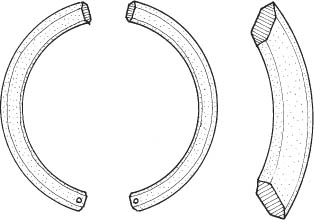25 1. Patient should not wear eye makeup on day of procedure. 2. Treat preexisting dry eye and blepharitis. Consider non-preserved lubricants, lid hygiene, punctual plugs, topical cyclosporine, and oral doxycycline for blepharitis. 3. Assess refraction, keratometry, and corneal topography for axis of Intacs placement and proper size of Intacs segments: Nominal expected correction: 250 μm segments: -1.3 diopters 300 μm segments: -2.0 diopters 350 μm segments: -2.7 diopters 400 μm segments: -3.4 diopters 450 μm segments: -4.1 diopters Note: Segments may be placed asymmetrically for noncentered cones. For peripherally displaced cones, one segment may be considered to improve asymmetry in corneal topography. Figure 25.1
Intracorneal Ring Segments (INTACS)
Indications
 Surgical management of keratoconus in patient intolerant of contact lens treatment.
Surgical management of keratoconus in patient intolerant of contact lens treatment.
 Primary goal to restore contact lens tolerance and prevent need for penetrating keratoplasty.
Primary goal to restore contact lens tolerance and prevent need for penetrating keratoplasty.
 Secondary goal to improve spectacle and uncorrected visual acuity.
Secondary goal to improve spectacle and uncorrected visual acuity.
 Surgical management of post-LASIK ectasia.
Surgical management of post-LASIK ectasia.
 Mild to moderate natural myopia.
Mild to moderate natural myopia.
Contraindications
 Visually significant corneal scar.
Visually significant corneal scar.
 Corneal thickness at Intacs entry site < 450 μm; thinnest pachymetry < 350.
Corneal thickness at Intacs entry site < 450 μm; thinnest pachymetry < 350.
Preoperative Procedure
Instrumentation
 Intacs specifications (Fig. 25.1):
Intacs specifications (Fig. 25.1):
 Hexagonal cross section
Hexagonal cross section
 6.8 mm inner diameter; 8.1 mm outer diameter
6.8 mm inner diameter; 8.1 mm outer diameter
 150 degree arc length
150 degree arc length
 Available thickness: 250, 300, 350 μm; 400, 450 μm pending FDA approval
Available thickness: 250, 300, 350 μm; 400, 450 μm pending FDA approval
 Lid speculum
Lid speculum
 Gentian violet marking pen or pad
Gentian violet marking pen or pad
 C ellulose sponges
C ellulose sponges
 Intacs console
Intacs console
 Incision and placement marker
Incision and placement marker
 Pocketing hook
Pocketing hook
Stay updated, free articles. Join our Telegram channel

Full access? Get Clinical Tree



